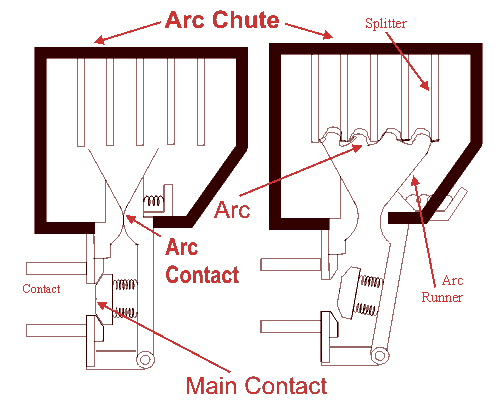Air circuit breaker working principle; Air circuit breaker
Air circuit breakers as clear from the name that these circuit breakers operate at atmospheric pressure. ACBs are still preferable choice up to voltage 15 KV. Even ACB’s can be used for LT also . MCCB’s can be used upto 630/ 800A above that limit air circuit breakers are used.
Working Principle of Air Circuit Breaker
Main aim for every circuit breaker is to prevent rebuilt of arcing after electric current goes zero by creating a situation where in the contact gap will withstand the system recovery voltage. For interrupting arc it creates an arc voltage in excess of the supply voltage. Arc voltage is defined as the minimum voltage required maintaining the arc.
This circuit breaker increases the arc voltage by mainly three different ways,
- Air circuit breaker increases the arc voltage by cooling the arc plasma. As the temperature of arc plasma is decreased, the mobility of the particle in arc plasma is reduced; hence more voltage gradient is required to maintain the arc.
- It may increase the arc voltage by lengthening the arc path. As the length of arc path is increased, the resistance of the path is increased, and hence to maintain the same arc electric current more voltage is required to be applied across the arc path. That means arc voltage is increased.
- Splitting up the arc into a number of series arcs also increases the arc voltage.
OPERATIONAL PROCEDURE OF ACB
Every circuit breaker objective is usually to increase the arc area this can be achieved by forcing the arc into contact with as large an area as possible of insulating material. There are arc chutes in every circuit breaker usually arc is driven into it. Arc chute is suitably shaped in such a way to help to achieve cooling. This type of arc chute should be made from some kind of refractory material. High temperature plastics reinforced with glass fiber and ceramics are preferable materials for making arc chute.
There is further arc slitter inside the arc chute. The main arc chute is divided into numbers of small compartments by using metallic separation plates. These metallic separation plates are actually the arc splitters and each of the small compartments behaves as individual mini arc chute. In this system the initial arc is split into a number of series arcs, each of which will have its own mini arc chute. So each of the split arcs has its own cooling and lengthening effect due to its own mini arc chute and hence individual split arc voltage becomes high. These collectively, make the overall arc voltage, much higher than the system voltage.
This was working principle of air circuit breaker now we will discuss in details the operation of ACB in practice.
The air circuit breaker, operated within the voltage level 1 KV, does not require any arc control device.
During breaking of a circuit breaker arc is produced which needed to be quenched as earlier as possible so that arc doesn’t re-strike. Circuit breakers usually named after the Medium in which circuit breaker breaks or medium used to quench the arc during breaking of circuit breaker. In Air circuit breaker air serves the same purpose.
Mainly for heavy fault electric current on low voltages ACBs with appropriate arc control device, are good choice. These breakers normally have two pairs of contacts. The main pair of contacts carries the electric current at normal load and these contacts are made of copper. The additional pair is the arcing contact and is made of carbon. When circuit breaker is being opened, the main contacts open first and during opening of main contacts the arcing contacts are still in touch with each other. As the electric current gets, a parallel low resistive path through the arcing contact during opening of main contacts, there will not be any arcing in the main contact. The arcing is only initiated when finally the arcing contacts are separated. The each of the arc contacts is fitted with an arc runner which helps, the arc discharge to move upward due to both thermal and electromagnetic effects as shown in the figure. As the arc is driven upward it enters in the arc chute, consisting of splitters. The arc in chute will become colder, lengthen and split hence arc voltage becomes much larger than system voltage at the time of operation of air circuit breaker, and therefore the arc is quenched finally during the electric current zero.
Air circuit breakers working is shown above which self explanatory.
Although this type of circuit breakers have become obsolete for medium voltage application, but they are still preferable choice for high electric current rating in low voltage application.
Advantages of air circuit breakers
- There is no chance of fire hazard which usually occur in Oil circuit breaker.
- The breaking speed of Air circuit breaker is much higher than oil circuit breaker.
- Arc quenching is much faster in case of air circuit breaker than oil circuit breaker.
- As the duration of arc is smaller, so lesser amount of heat realized from arc to electric current carrying contacts hence the service life of the contacts becomes longer.
- The stability of the system can be well maintained as it depends on the speed of operation of circuit breaker.
- Requires much less maintenance compared to oil circuit breaker.
There are also some disadvantages of air blast circuit breakers-
- In order to have frequent operations, it is necessary to have sufficiently high capacity air compressor.
- Frequent maintenance of compressor, associated air pipes and automatic control equipments is also required.
- Due to high speed electric current interruption there is always a chance of high rate of rise of re-striking voltage and electric current chopping.
- There also a chance of air pressure leakage from air pipes junctions.



Comments
Post a Comment